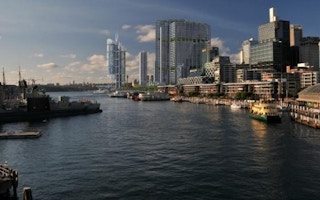The building sector is about to ride the new energy revolution currently spreading across the world, said the head of the World Green Building Council (WGBC) to participants at a green building conference in Singapore on Thursday.
WGBC chief executive Jane Henley told several hundred green business experts that after passively watching five previous waves of energy revolutions, the building sector would get in on the action this time.
Speaking at a plenary session on the second day of the International Green Building Conference, Ms Henley defined energy revolutions as waves of innovation that transform the way the world operates.
She described previous revolutions such as the water-powered industrial revolution, the innovations in steam that brought railways, simultaneous innovations in electricity and steel that brought the world power stations, the age of assembly lines and oil-fuelled motor cars, and - the most recent wave – the information and communication transformation triggered by the silicon chip.
“My question is - are we on the verge of another transformation?” she asked.
It seems like conditions are right, she said, citing factors such as climate change, peak oil, an increase in droughts and other extreme weather events, new policies on carbon pricing and increasing consumption in modernising countries. All of these trends point towards a growing awareness of resource scarcity.
Ms Henley noted that each new wave has been characterised by the emergence of disruptive, or game-changing, technology that increased conflict between the traditional industry players who dominate the market and the innovators. That phase is followed by several decades of innovation and trial and error.
The early adopters of the new technologies see opportunities everywhere, and seek out advantages over traditional business models, she added.
“We are still in the early adoption phase of innovation as we enter into this energy revolution,” said Ms Henley, adding that current efforts to develop smart grids, improve clean energy financing options and accelerate renewable energy solutions are part of the phase.
What makes the coming wave different from previous transformations – at the least for the building sector - is the opportunity for the industry to play an important role in the shift to resource efficiency at every level of society, she explained.
“Previous waves have transformed our buildings and cities forever, but the built environment has only ever been a bystander, providing space for business and people,” said Ms Henley.
Rod Leaver, chief executive of international property developer Lend Lease Asia - who also spoke at the event - agreed that the building industry has been static for too long. He said that the industry has shown no real productivity gains in the past 40 years, but that it had the ability to make the biggest and most cost effective impacts on sustainability.
Lend Lease is widely recognised as one the green building movement’s early adopters. The company, an early signatory of multiple global sustainability initiatives such as the United Nations’ Principles for Responsible Investment, is one of a growing number of developers moving beyond greening one building at a time.
For example, Mr Leaver highlighted several urban planning projects that involve greening entire districts and communities. One such project is the Barangaroo development in Sydney, which is being redeveloped from an underutilised waterfront area into a new, community friendly space.
WGBC’s Ms Henley said that early adopters, with encouragement by government incentives, can raise the standards for sustainability within the industry. As expectations rise, she added, governments can in turn raise the minimum standards required by regulations.
Speaking to Eco-Business after, she said that eventually governments will outlaw the most unsustainable practices, such as the use of toxic chemicals in building materials. Perhaps, in 10 years, many companies will wish they had changed and innovated, she added.
The sustainability of building materials and its effect on the overall environmental impact of projects is of increasing concern in the global green building movement, noted Ms Henley.
The concept of sustainable buildings is changing and expanding to focus on issues such as the complete life cycle of buildings and the social impacts they might have on a community.
She told Eco-Business that the industry has traditionally approached the sustainable building concept from a purely environmental angle, and that developers are not used to looking at the potential social benefits, such as better air and productivity.
She added that some developing countries have taken the early, narrow version of the concept and adapted or improved it to better suit their needs. The Philippines, for example, chose to place a greater focus on social impacts in its rating system.
Another example she gave was the strong emphasis on affordable housing in countries such as Mexico, which has focused on poverty reduction and living conditions.
Ms Henley said that the industry was moving towards a more integrated view of sustainability – one that allows decisions to be based on a combination of social, economic and environmental factors. The key to achieving that vision, and the industry’s opportunity to join society’s transformation, she added, is to make sure everyone works together.
Lend Lease’s Mr Leaver urged the industry not to be left behind.
“Sustainability is our biggest disruptive wave. It is driving innovation and productivity gains for the whole industry. It is a freight train coming down the track. You can either get on it, or get run over,” he said.
Eco-Business.com’s coverage of the International Green Building Conference 2011 is brought to you by City Developments Limited (CDL).















